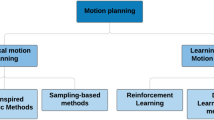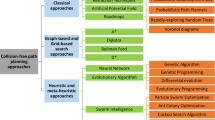Abstract
This paper introduces a new method to solve the collision-free path planning problem for industrial robots considering safe human–robot coexistence. The aim is to keep the robot at a safe distance away from the human and let the robot’s tip reach the target location through a smooth path. The proposed method is iterative, and each iteration provides random candidate waypoints for the robot’s tip. The waypoint that the robot will follow for each iteration is determined by solving the optimization problem. The objective function is formulated considering the distance between the human and the robot, as well as the criteria for the robot’s tip to reach the target by following a smooth path. The human and the robot in the environment are represented by the capsules, and the minimum distance calculation is performed between these capsules using the Gilbert–Johnson–Keerthi algorithm. The simulation results demonstrate the performance of the proposed method for different scenarios involving human–robot coexistence.




































Similar content being viewed by others
References
International Federation of Robotics (2020) Executive Summary World Robotics 2020 Industrial Robots. https://ifr.org/img/worldrobotics/Executive_Summary_WR_2020_Industrial_Robots_1.pdf. Accessed 30 Jan 2021
Magrini E, Ferraguti F, Ronga AJ, Pini F, De Luca A, Leali F (2020) Human–robot coexistence and interaction in open industrial cells. Robot Comput Integrat Manuf 61
Hentout A, Aouache M, Maoudj A, Akli I (2019) Human-robot interaction in industrial collaborative robotics: a literature review of the decade 2008–2017. Adv Robot 33:764–799
Villani V, Pini F, Leali F, Secchi C (2018) Survey on human–robot collaboration in industrial settings: Safety, intuitive interfaces and applications. Mechatronics 55:248–266
Ajoudani A, Zanchettin AM, Ivaldi S, Albu-Schäffer A, Kosuge K, Khatib O (2018) Progress and prospects of the human–robot collaboration. Auton Robot 42(5):957–975
Robla-Gómez S, Becerra VM, Llata JR, González-Sarabia E, Torre-Ferrero C, Pérez-Oria J (2017) Working together: a review on safe human-robot collaboration in industrial environments. IEEE Access 5:26754–26773
Marvel JA, Norcross R (2017) Implementing speed and separation monitoring in collaborative robot workcells. Robot Comput-Integr Manuf 44:144–155
Lasota PA, Rossano GF, Shah JA (2014) Toward safe close-proximity human–robot interaction with standard industrial robots. In: 2014 IEEE international conference on automation science and engineering (CASE)
Salmi T, Marstio I, Malm T, Montonen J (2016) Advanced safety solutions for human-robot-cooperation. In: Proceedings of ISR 2016: 47st international symposium on robotics
Long P, Chevallereau C, Chablat D, Girin A (2018) An industrial security system for human-robot coexistence. Ind Robot 45(2):220–226
Mohammed A, Schmidt B, Wang L (2017) Active collision avoidance for human–robot collaboration driven by vision sensors. Int J Comput Integr Manuf 30(9):970–980
Safeea M, Neto P (2019) Minimum distance calculation using laser scanner and IMUs for safe human-robot interaction. Robot Comput-Integr Manuf 58:33–42
Papanastasiou S, Kousi N, Karagiannis P, Gkournelos C, Papavasileiou A, Dimoulas K, Baris K, Koukas S, Michalos G, Makris S (2019) Towards seamless human robot collaboration: integrating multimodal interaction. Int J Adv Manuf Technol 105:3881–3897
Safeea M, Neto P, Bearee R (2019) Online collision avoidance for collaborative robot manipulators by adjusting offline generated paths: an industrial use case. Robot Auton Syst 119:278–288
Abo-Hammour ZS, Alsmadi OM, Bataineh SI, Al-Omari MA, Affach N (2011) Continuous genetic algorithms for collision-free cartesian path planning of robot manipulators. Int J Adv Rob Syst 8(6):14–36
Kuhn S, Henrich D (2007) Fast vision-based minimum distance determination between known and unknown objects. In: 2007 IEEE/RSJ international conference on intelligent robots and systems, San Diego, CA, USA
Han D, Nie H, Chen J, Chen M (2018) Dynamic obstacle avoidance for manipulators using distance calculation and discrete detection. Robot Comput-Integr Manuf 49:98–104
Gilbert EG, Johnson DW, Keerthi SS (1988) A fast procedure for computing the distance between complex objects in three-dimensional space. IEEE J Robot Autom 4(2):193–203
Bernabeu EJ, Tornero J (2002) Hough transform for distance computation and collision avoidance. IEEE Trans Robot Autom 18(3):393–398
Fischer M, Henrich D (20019) 3D collision detection for industrial robots and unknown obstacles using multiple depth images. Adv Robot Res 111–122
Ragaglia M, Zanchettin AM, Rocco P (2015) Safety-aware trajectory scaling for human–robot collaboration with prediction of human occupancy. In: 2015 International conference on advanced robotics (ICAR)
Khan AH, Li S, Luo X (2020) Obstacle avoidance and tracking control of redundant robotic manipulator: an RNN-based metaheuristic approach. IEEE Trans Industr Inf 16(7):4670–4680
Qiu Q, Cao Q (2018) Task constrained motion planning for 7-degree of freedom manipulators with parameterized submanifolds. Ind Robot 45(3):363–370
Gao M, Chen D, Yang Y, He Z (2015) A fixed-distance planning algorithm for 6-DOF manipulators. Ind Robot 42(6):586–599
Wang W, Zhu M, Wang X, He S, He J, Xu Z (2018) An improved artificial potential field method of trajectory planning and obstacle avoidance for redundant manipulators. Int J Adv Rob Syst 15(5):1–13
Lozano-Perez T (1983) Spatial planning: a configuration space approach. IEEE Trans Comput 32(2):108–120
La Valle SM (2006) Planning algorithms. Cambridge University Press, Cambridge
Khatib O (1986) Real-time obstacle avoidance for manipulators and mobile robots. Int J Robot Res 5(1):90–98
Stentz A (1994) Optimal and efficient path planning for partially-known environments. In: Proceedings of the 1994 IEEE international conference on robotics and automation
Zavlangas PG, Tzafestas SG (2000) Industrial robot navigation and obstacle avoidance employing fuzzy logic. J Intell Rob Syst 27:85–97
Siciliano B (1990) Kinematic control of redundant robot manipulators: a tutorial. J Intell Rob Syst 3:201–212
Lee K-K, Buss M (2007) Obstacle avoidance for redundant robots using jacobian transpose method. In: Proceedings of the 2007 IEEE/RSJ international conference on intelligent robots and systems
Kelemen M, Virgala I, Lipták T, Miková Ľ, Filakovský F, Bulej V (2018) A novel approach for a inverse kinematics solution of a redundant manipulator. Appl Sci 8(11):2229
Lillo PD, Chiaverini S, Antonelli G (2019) Handling robot constraints within a set-based multi-task priority inverse kinematics framework. In: 2019 international conference on robotics and automation (ICRA), pp 7477–7483
Liu J, Tong Y, Ju Z, Liu Y (2020) Novel method of obstacle avoidance planning for redundant sliding manipulators. IEEE Access 8:78608–78621
Flacco F, Kröger T, De Luca A, Khatib O (2012) A depth space approach to human-robot collision avoidance. In: 2012 IEEE international conference on robotics and automation (ICRA)
Kivela T, Mattila J, Puura J, Launis S (2018) Redundant robotic manipulator path planning for real-time obstacle and self-collision avoidance. Adv Serv Industr Robot 49:208–216
Safeea M, Bearee R, Neto P (2020) Collision avoidance of redundant robotic manipulators using Newton’s method. J Intell Rob Syst 99:673–681
Tsai C-S (2014) Online trajectory generation for robot manipulators in dynamic environment - an optimization-based approach. PhD thesis, Mechanical Engineering, University of California, Berkeley
Cefalo M, Magrini E, Oriolo G (2018) Sensor-based task-constrained motion planning using model predictive control. IFAC PapersOnLine 51(22):220–225
Lin H, Fan Y, Tang T, Tomizuka M (2016) Human guidance programming on a 6-DoF robot with collision avoidance. 2016 IEEE/RSJ international conference on intelligent robots and systems (IROS), pp 2676–2681
Mao H, Xiao J (2019) Real-time conflict resolution of task-constrained manipulator motion in unforeseen dynamic environments. IEEE Trans Rob 35(5):1276–1283
Balan L, Bone GM (2006) Real-time 3D collision avoidance method for safe human and robot coexistence. In: 2006 IEEE/RSJ international conference on intelligent robots and systems, pp 276–282
Secil S, Ozkan M (2022) Minimum distance calculation using skeletal tracking for safe human-robot interaction. Robot Comput-Integr Manuf 73:102253
Nuitrack. Nuitrack full body skeletal tracking software. https://nuitrack.com/. Accessed 21 Dec 2020
Cubemos. Skeleton Tracking SDK. https://www.cubemos.com/skeleton-tracking-sdk. Accessed 21 Dec 2020
LIPS "3D Body Skeleton | LIPS Corporation. https://www.lips-hci.com/3d-body-skeleton. Accessed 21 Dec 2020
Schmidt B, Wang L (2014) Depth camera based collision avoidance via active robot control. J Manuf Syst 33:711–718
Safeea M, Neto P, Bearee R (2020) Efficient calculation of minimum distance between capsules and its use in robotics. J Intell Rob Syst 99:673–681
Olvång L. Real-time collision detection with implicit objects (Dissertation). Department of Information Technology, Uppsala University, 2010. Available: http://urn.kb.se/resolve?urn=urn:nbn:se:uu:diva-129453. Accessed Mar 2023
Horaud R, Dornaika F (1995) Hand-eye calibration. Int J Robot Res 14(3):195–210
Gilbert EG, Foo C-P (1990) Computing the distance between general convex objects in three-dimensional space. IEEE Trans Robot Autom 6:53–61
Khungrun P. “Probability Density Under Transformation.”, Cornell University, 2015. [Online]. Available: https://www.cs.cornell.edu/courses/cs6630/2015fa/notes/pdf-transform.pdf. Accessed May 2021
MATLAB® Robotics System Toolbox™, "Robotics System Toolbox Documentation." The MathWorks, Inc. [Online]. Available: https://www.mathworks.com/help/robotics/index.html. Accessed 24 Aug 2021
FCL. flexible-collision-library/fcl. The Flexible Collision Library. [Online]. Available: https://github.com/flexible-collision-library/fcl. Accessed 29 Mar 2023
Kawasaki Robotics (2023) "Operation Manual Kawasaki Robots.", Kawasaki Robotics. [Online]. Available: https://kawasakirobotics.nl/index.php?id_product=126&rewrite=operation-manual-kawasaki-robots&controller=product&id_lang=1. Accessed 12 April 2023
Funding
The authors did not receive support from any organization for the submitted work. No funding was received to assist with the preparation of this manuscript. The authors have no relevant financial or non-financial interests to disclose.
Author information
Authors and Affiliations
Corresponding author
Ethics declarations
Competing interests
The authors have no competing interests to declare that are relevant to the content of this article.
Additional information
Publisher's Note
Springer Nature remains neutral with regard to jurisdictional claims in published maps and institutional affiliations.
Electronic supplementary material
Below is the link to the electronic supplementary material.
Supplementary file 1 (MP4 6334 KB)
Appendix: Uniform distribution over a unit sphere surface
Appendix: Uniform distribution over a unit sphere surface
For the uniform distribution over a unit sphere surface with an area of 4π, the probability density should be constant, which is \(p\left(x\right)= \frac{1}{4\pi }\). At the same time, the probability that a point lies in the differential surface area can be expressed as \(p\left(x\right) dA\). In this case, Eq. (34) can be used to find the probability density function \(p\left(\phi ,\ominus \right)\) that constitutes a uniform distribution on the sphere.
Since surface element \(dA=\mathrm{sin}\ominus d\ominus d\phi \), the probability density function becomes:
When the spherical coordinates \(\ominus \) and \(\phi \) are desired to be sampled independently of each other so that \(p\left(\phi ,\ominus \right)=p\left(\phi \right)p\left(\ominus \right)\), the probability density functions are given by:
It is obvious that \(\phi \) is uniformly distributed with a constant distribution, while probability density \(p\left(\ominus \right)\) varies with \(\mathrm{sin}\ominus \). Therefore, \(p\left(\ominus \right)\) can be sampled by using the inverse transform sampling. The cumulative distribution functions \(P\left(\ominus \right)\) and \(P\left(\phi \right)\) are needed to generate \(\ominus \) and \(\phi \) in this method given by:
If two random variables \(u\) and \(v\), which are both uniform on the interval \([\mathrm{0,1}]\), are chosen so that \(P\left(\phi \right)=u\) and \(P\left(\ominus \right)=v\), then inverse functions of the cumulative distribution functions gives:
Rights and permissions
Springer Nature or its licensor (e.g. a society or other partner) holds exclusive rights to this article under a publishing agreement with the author(s) or other rightsholder(s); author self-archiving of the accepted manuscript version of this article is solely governed by the terms of such publishing agreement and applicable law.
About this article
Cite this article
Secil, S., Ozkan, M. A collision-free path planning method for industrial robot manipulators considering safe human–robot interaction. Intel Serv Robotics 16, 323–359 (2023). https://doi.org/10.1007/s11370-023-00465-7
Received:
Accepted:
Published:
Issue Date:
DOI: https://doi.org/10.1007/s11370-023-00465-7




